2019 年 12 月六级第一套
Writing
Listening Comprehension
(30 minutes)
(30 minutes)
Part I
Directions: For this part you are allowed 30 minutes to write an essay on the importance of
having a sense family responsibility. You should write at least 150 words but no more than
200 words.
Part II
Section A
Directions:Inthissection,youwillheartwolongconversations.Attheendofeachconversation,
youwillhearfourquestions.Boththeconversationandthequestionswillbespokenonlyonce.
After you hear a question, you must choose the best answer from the four choices marked A),
B),C),andD).ThenmarkthecorrespondingletteronAnswerSheet1withasinglelinethrough
the centre.
Questions 1 to 4 are based on the conversation you have just heard.
B) Fashion designer.
1.A) Magazine reporter.
D) Features editor.
C) Website designer.
B) Consulting fashion experts.
2.A) Designing sports clothing.
C) Answering daily emails.
D) Interviewing job-seekers.
3.A) It is challenging.
C) It is tiresome.
4.A) Her persistence.
C) Her competence.
B) It is fascinating.
D) It is fashionable.
B) Her experience.
D) Her confidence.
Questions 5 to 8 are based on the conversations you have just heard.
B) It is educational.
5.A) It is enjoyable.
C) It is divorced from real life.
D) It is adapted from a drama.
6.A) All the roles are played by famous actors and actress.
B) It is based on the real-life experiences of some celebrities.
C) Its plots and events reveal a lot about Frankie’s actual life.
D) It is written, directed, edited and produced by Frankie himself.
7.A) Go to the theater and enjoy it.
B) Recommend it to her friends.
C) Watch it with the man.
D) Download and watch it.
8.A) It has drawn criticisms from scientists.
decade.
B) It has been showing for over a
C) It is a ridiculous piece of satire.
D) It is against common sense.
Section B
Directions:In thissection,you will hear two passages. At the end of each passage,you will
hear three or four questions. Both the passage and the questions will be spoken only once.
Afteryouhearaquestion,youmustchoosethebestanswerfromthefourchoicesmarkedA),B),C)
and D). Then mark the corresponding letter on Answer Sheet I with a single line through the
center.
Questions 9 to 11 are based on the passage you have just heard.
9.A)They are likely to get hurt when moving too fast.
B)They believe in team spirit.
C) They need to keep moving to avoid getting hurt.
�
D)They have to learn how to avoid body contact.
10.A) They do not have many years to live after retirement.
B)They tend to live longer with early retirement.
C)They do not start enjoying life until full retirement.
D)They keep themselves busy even after retirement.
11.A)It prevents us from worrying.
B)It slows down our aging process.
C)It enables us to accomplish in life.
D)It provides us with more chances to
learn.
Questions 12 to 15 are based on the passage you have just heard.
12.A)It tends to dwell upon their joyous experiences.
B) It wanders for almost half of their waking time.
C)It has trouble concentrating alter a brain injury.
D)It tends to be affected by their negative feelings.
13.A) To find how happiness relates to daydreaming.
B)To observe how one’s mind affects one’s behavior.
C)To see why daydreaming impacts what one is doing.
D)To study the relation between health and daydreaming.
14.A)It helps them make good decisions.
B)It helps them tap their potentials.
C) It contributes to their creativity.
D)It contributes to their thinking.
15.A)Subjects with clear goals in mind outperformed those without clear goals.
B)The difference in performance between the two groups was insignificant.
C)Non-daydreamers were more confused on their tasks than daydreamers.
D) Daydreamers did better than non-daydreamers in task performance.
Questions 19 to 21 are based on the recording you have just heard.
19. A) Similarities between human babies and baby animals.
B) Cognitive features of different newly born mammals.
C) Adults’ influence on children.
D) Abilities of human babies.
20. A) They can distinguish a happy tune from a sad one.
B) They love happy melodies more than sad ones.
C) They fall asleep easily while listening to music.
D) They are already sensitive to beats and rhythms.
21. A) Infants’ facial expressions.
B) Babies’ emotions.
C) Babies’ interaction with adults.
D) Infants’ behaviors.
Questions 22 to 25 are based on the recording you have just heard.
22. A) It may harm the culture of today’s workplace.
B) It may hinder individual career advancement.
C) It may result in unwillingness to take risks.
D) It may put too much pressure on team members.
23. A) They can hardly give expression to their original views.
B) They can become less motivated to do projects of their own.
C) They may find it hard to get their contributions recognized.
D) They may eventually lose their confidence and creativity.
24. A) They can enlarge their professional circle.
B) They can get chances to engage in
�
research.
C) They can make the best use of their expertise.
D) They can complete the project
more easily.
25. A) It may cause lots of arguments in a team.
B) It may prevent making a timely decision.
C) It may give rise to a lot of unnecessary expenses.
D) It may deprive a team of business opportunities.
Reading Comprehension
Part III
Section A
Directions:In this section, there is a passage with ten blanks. You are required to select
one word for each blank from a list of choices given in a word bank following the passage.
Read the passage through carefully before making your choices. Each choice in the bank is
identified by a letter. Please mark the corresponding letter for each item on Answer Sheet
2 with a single line through the centre. You may not use any of the words in the bank more
than once.
(40 minutes)
When considering risk factors associated with serious chronic diseases, we often think about
health indicators such as cholesterol, blood pressure, and body weight. But poor diet and
physical inactivity also each increase the risk of heart disease and have a role to play in
effects of an unhealthy diet and
the development of some cancers. Perhaps worse, the
insufficient exercise are not limited to your body. Recent research has also shown that
27
in a high-fat and high-sugar diet may have negative effects on your brain, causing learning
and memory
26
28
.
Studies have found obesity is associated with impairments in cognitive functioning, as
29
by a range of learning and memory tests, such as the ability to remember a list of words presented
some minutes or hours earlier. There is also a growing body of evidence that diet-induced
cognitive impairments can emerge
-within weeks or even days. For example, one study
found healthy adults
to a high-fat diet for five days showed impaired attention, memory,
and mood compared with a low-fat diet control group. Another study also found eating a high-fat
and high-sugar breakfast each day for as little as four days resulted in problems with learning
and memory
to those observed in overweight and obese individuals.
30
31
32
Body weight was not hugely different between the groups eating a healthy diet and those
of poor dietary intake can occur
. Thus, body weight is not always the best
on high fat and sugar diets. So this shows negative
even when body weight has not changed
indicator of health and a thin person still needs to eat well and exercise
35
.
33
34
A) assessedF) designatedK) loopholes
B) assignedG) detrimentalL) rapidly
C)consequencesH) digestionM) redundant
D) conspicuously
E) deficits
I) excellingN) regularly
J) indulgingO) similar
Section B
Directions:In thissection, you are going to read a passagewith ten statements attached to
it.Eachstatementcontainsinformationgiveninoneoftheparagraphs.Identifytheparagraph
�
fromwhichtheinformationisderived.Youmaychooseaparagraphmorethanonce.Eachparagraph
is marked with a letter. Answer the question by marking the corresponding letter on Answer
Sheet 2.
Increased Screen Time and Wellbeing Decline in Youth
[A] Have young people never had it so good? Or do they face more challenges than any previous
generation? Our current era in the West is one of high wealth. This means minors enjoy material
benefits and legal protections that would have been the envy of those living in the past. But
there is an increasing suspicion that all is not well for our youth. And one of the most popular
explanations, among some experts and the popular media, is that excessive “screen time” is
to blame (This refers to all the attention young people devote to their phones, tablets and
laptops). However, this is a connection theory and such claims have been treated skeptically
by some scholars based on their reading of the relevant data.
[B] Now a study in the journal Emotion has provided another contribution to the debate,
uncovering strong evidence that adolescent wellbeing in the United States really is
experiencing a decline and arguing that the most likely cause is the electronic riches we have
given them. The background to this is that from the 1960s into the early 2000s, measures of
average wellbeing went up in the US.This was especially true for younger people. It reflected
the fact that these decades saw a climb in general standards of living and avoidance of mass
societal traumas like full-scale war or economic deprivation. However, the “screen time”
hypothesis, advanced by researchers such as Jean Twenge, is that electronic devices and
excessive time spent online may have reversed these trends in recent years, causing problems
for young people’s psychological health.
[C] To investigate, Twenge and her colleagues dived into the “Monitoring The Future” dataset
based on annual surveys of American school students from grades 8, 10, and 12 that started
in 1991. In total, 1.1 million young people answered various questions related to their
wellbeing. Twenge’s team’s analysis of the answers confirmed the earlier, well-established
wellbeing climb, with scores rising across the 1990s, and into the later 2000s. This was found
across measures like self-esteem, life satisfaction, happiness and satisfaction with
individual domains like job, neighborhood, or friends. But around 2012 these measures started
to decline. This continued through 2016, the most recent year for which data is available.
[D] Twenge and her colleagues wanted to understand why this change in average wellbeing has
occurred. However, it’s very hard to demonstrate causes in non-experimental data such as this.
In fact, when Twenge previously used this data to suggest a screen time effect, some
commentators were quick to raise this problem.They argued that her causal-sounding claims
rested on correlational data, and that she had not adequately accounted for other potential
causal factors. This time around, Twenge and her team make a point of saying that that they
are not trying to establish causes as such, but that they are assessing the plausibility of
potential causes.
[E] First, they explain that if a given variable is playing a causal role in affecting wellbeing,
then we should expect any change in that variable to correlate with the observed changes in
wellbeing. If not, it isn’t plausible that the variable is a causal factor. So the researchers
looked at time spent in a number of activities that could plausibly be driving the wellbeing
decline. Less sport, and fewer meetings with peers correlated with lower wellbeing, as did
�
less time reading print media (newspapers) and, surprisingly, less time doing homework (This
last finding would appear to contradict another popular hypothesis that it is our burdening
of students with assignments that is causing all the problems). In addition, more TV watching
and more electronic communication both correlated with lower wellbeing. All these effects held
true for measures of happiness, life satisfaction and self-esteem, with the effects stronger
in the 8th and 10th-graders.
[F] Next, Twenge’s team dug a little deeper into the data on screentime. They found that
adolescents who spent a very small amount of time on digital devices—a couple of hours—
had the highest wellbeing. Their wellbeing was even higher than those who never used such
devices. However, higher doses of screentime were clearly associated with lower happiness.
Those spending 10-19 hours per week on their devices were 41 percent more likely to be unhappy
than lower-frequency users. Those who used such devices 40 hours a week or more (one in ten
of teenagers) were twice as likely to be unhappy. The data was slightly complicated by the
fact that there was a tendency for kids who were social in the real world to also use more
online communication, but by bracketing out different cases it became clear that the real-world
sociality component correlated with greater wellbeing, whereas greater time on screens or
online only correlated with poorer wellbeing.
[G] So far, so plausible. But the next question is, are the drops in average wellbeing happening
at the same timeas trends toward increased electronic device usage? It looks like it—after
all, 2012 was the tipping point when more than half of Americans began owning smartphones.
Twenge and her colleagues also found that across the key years of 2013-16, wellbeing was indeed
lowest in years where adolescents spent more time online, on social media, and reading news
online, and when more youth in the US had smartphones. And in a second analysis, they found
that where technology went, dips in wellbeing followed.For instance, years with a larger
increase in online usage were followed by years with lower wellbeing, rather than the other
way around. This does not prove causality, but is consistent with it. Meanwhile, TV use didn’t
show this tracking. TV might make you less happy, but this isnot what seems to be driving the
recent declines in young people’s average happiness.
[H] A similar but reversed pattern was found for the activitiesassociated with greater
wellbeing. For example, years where people spent more time with friends were better years for
wellbeing (and followed by better years). Sadly, the data also showed face-to-face socializing
and sports activity had declined over the period covered by the survey.
[I] There is another explanation that Twenge and her colleagues wanted to address: the impact
of the great recession of 2007-2009, which hit a great number of American families and might
be affecting adolescents. The dataset didn’t include economic data, so instead the researchers
looked at whether the 2013-16 wellbeing decline was tracking economic indicators. They found
some evidence that some crude measures, like income inequality, correlated with changes in
wellbeing, but economic measures with a more direct impact, like family income and unemployment
rates (which put families into difficulties), had no relationship with wellbeing. The
researchers also note that the recession hit some years before we see the beginning of the
wellbeing drop, and before the steepest wellbeing decline, which occurred in 2013.
[J] The researchers conclude that electronic communication was the only adolescent activity
that increased at the same time psychological wellbeing declined. I suspect that some experts
in the field will be keen to address alternative explanations, such as unassessed variables
�
playing a role in the wellbeing decline. But the new work does go further than before and
suggests that screen time should still be considered a potential barrier to young people’s
flourishing.
36. The year when most Americans began using smartphones was identified as a turning point
in young Americans’ level of happiness.
37. Scores in various wellbeing measures began to go downward among young Americans in recent
years.
38. Unfortunately, activities involving direct contact with people, which contributed to
better wellbeing, were found to be on the decline.
39. In response to past critics, Twenge and her co-researchers stress they are not trying to
prove that the use of digital devices reduces young people’s wellbeing.
40. In the last few decades of the 20th century, living standards went up and economic depressions
were largely averted in the US.
41. Contrary to popular belief, doing homework might add to students’ wellbeing.
42. The author believes the researchers’ new study has gone a step further regarding the impact
of screen time on wellbeing.
43. The researchers found that extended screen time makes young people less happy.
44. Data reveals that economic inequality rather than family income might affect people’s
wellbeing.
45. Too much screen time is widely believed to be the cause of unhappiness among today’s young
people.
Section C
Directions:There are2 passagesin thissection.Eachpassage is followed bysomequestions
or unfinished statements. For each of them there are four choices marked A), B), C) and D).
YoushoulddecideonthebestchoiceandmarkthecorrespondingletteronAnswerSheet2with
a single line through the centre.
Passage One
Questions 46 to 50 are based on the following passage.
“The dangerous thing about lying is people don’t understand how the act changes us,”
said Dan Ariely, behavioral psychologist at Duke University.Psychologists have documented
children lying as early as the age of two. Some experts even consider lying a developmental
milestone, like crawling and walking, because it requires sophisticated planning, attention
and the ability to see a situation from someone else’s perspective to manipulate them. But,
for most people, lying gets limited as we develop a sense of morality and the ability to
self-regulate.
Harvard cognitive neuroscientist Joshua Greene said, for most of us, lying takes work.
In studies, he gave study subjects a chance to deceive for monetary gain while examining their
brains in a functional MRI machine, which maps blood flow to active parts of the brain. Some
people told the truth instantly and instinctively. But others opted to lie, and they showed
increased activity in their frontal parietal control network, which is involved in difficult
or complex thinking. This suggests that they were deciding between truth and dishonesty—and
ultimately opting for the latter. For a follow-up analysis, he found that people whose neural
�
reward centers were more active when they won money were also more likely to be among the group
of liars—suggesting that lying may have to do with the inability to resist temptation.
External conditions also matter in terms of when and how often we lie. We are more likely
to lie, research shows when we are able to rationalize it, when we are stressed and fatigued
or see others being dishonest. And we are less likely to lie when we have moral reminders or
when we think others are watching.“We as a society need to understand that, when we don’t
punish lying, we increase the probability it will happen again,” Ariely said.
In a 2016 study published in the journal Nature Neuroscience, Ariely and colleagues showed
how dishonesty alters people’s brains, making it easier to tell lies in the future. When people
uttered a falsehood, the scientists noticed a burst of activity in their amygdala. The amygdala
is a crucial part of the brain that produces fear, anxiety and emotional responses—including
that sinking, guilty feeling you get when you lie.But when scientists had their subjects play
a game in which they won money by deceiving their partner, they noticed the negative signals
from the amygdala began to decrease. Not only that, but when people faced no consequences for
dishonesty, their falsehoods tended to get even more sensational. This means that if you give
people multiple opportunities to lie for their own benefit, they start with little lies and
get bigger and bigger over time.
46. Why do some experts consider lying a milestone in a child’s development?
A) It shows they have the ability to view complex situations from different angles.
B) It indicates they have an ability more remarkable than crawling and walking.
C) It represents their ability to actively interact with people around them.
D) It involves the coordination of both their mental and physical abilities.
47. Why does the Harvard neuroscientist say that lying takes work?
A) It is difficult to sound natural or plausible.
options.
C) It involves lots of sophisticated mental activity.
into one’s brain.
48. Under what circumstances do people tend to lie?
B) It is hard to choose from several
D) It requires speedy blood flow
A) When they become too emotional.
C) When the temptation is too strong.
imminent.
49. When are people less likely to lie?
B) When they face too much peer pressure.
not
consequences
are
D)
When
the
A) When they are worn out and stressed.
C) When they think in a rational way.
B) When they are under watchful eyes.
D) When they have a clear conscience.
50. What does the author say will happen when a liar does not get punished?
A) They may feel justified.
C) They will become complacent.
B) They will tell bigger lies.
D) They may mix lies and truths.
Passage Two
Questions 51 to 55 are based on the following passage.
Here’s how the Pacific Northwest is preparing for “The Big One”. It’s the mother of
all disaster drills for what could be the worst disaster in American history. California has
spent years preparing for “The Big One”—the inevitable earthquake that will undoubtedly
unleash all kinds of havoc along the famous San Andreas fault. But what if the fault that runs
�
along the Pacific Northwest delivers a gigantic earthquake of its own? If the people of the
Cascadia region have anything to do with it, they won’t be caught unawares.
The region is engaged in a multi-day earthquake and tsunami drill involving around 20,000
people. The Cascadia Rising drill gives area residents and emergency responders a chance to
practice what to do in case of a 9.0 magnitude earthquake and tsunami along one of the nation’s
dangerous—and underestimated—faults.
The Cascadia Subduction Zone is big enough to compete with San Andreas (it’s been called
the most dangerous fault in America), but it’s much lesser known than its California cousin.
Nearly 700 miles long, the earthquake zone is located by the North American Plate off the coast
of Pacific British Columbia, Washington, Oregon and Northern California.
Cascadia is what’s known as a “megathrust” fault. Megathrusts are created in subduction
zones—land plate boundaries where two plates converge. In the areas where one plate is beneath
another, stress builds up over time. During a megathrust event, all of that stress releases
and some of the world’s most powerful earthquakes occur. Remember the 9.1 earthquake and
tsunami in the Indian Ocean off of Sumatra in 2004? It was caused by a megathrust event as
the India plate moved beneath the Burma micro-plate.
The last time a major earthquake occurred along the Cascadia fault was in 1700, so officials
worry that another event could occur at any time. To prevent that event from becoming a
catastrophe, first responders will join members of the public in rehearsals that involve
communication, evacuation, search and rescue, and other scenarios.
Thousands of deaths and other casualties are expected if a 9.0 earthquake were to occur.
First, the earthquake would shake metropolitan areas including Seattle and Portland. This could
trigger a tsunami that would create havoc along the coast. Not all casualties can necessarily
be prevented—but by coordinating across local, state, and even national borders, officials
hope that the worst-case scenario can be averted. On the exercise’s website, officials explain
that the report they prepare during this rehearsal will inform disaster management for years
to come.
For hundreds of thousands of Cascadia residents, the big one isn’t a question of if, only
when. And it’s never too early to get ready for the inevitable.
51. What does “The Big One” refer to?
A) A gigantic geological fault.
disasters.
B) A large-scale exercise to prepare for
C) A massive natural catastrophe.
D) A huge tsunami on the California
coast.
52. What is the purpose of the Cascadia Rising drill?
A) To prepare people for a major earthquake and tsunami.
B) To increase residents’ awareness of imminent disasters.
C) To teach people how to adapt to post-disaster life.
D) To cope with the aftermath of a possible earthquake.
53. What happens in case of a megathrust earthquake according to the passage?
A) Two plates merge into one.
C) A variety of forces converge.
B) Boundaries blur between plates.
D) Enormous stress is released.
54. What do the officials hope to achieve through the drills?
A) Coordinating various disaster-relief efforts. B) Reducing casualties in the event of
�
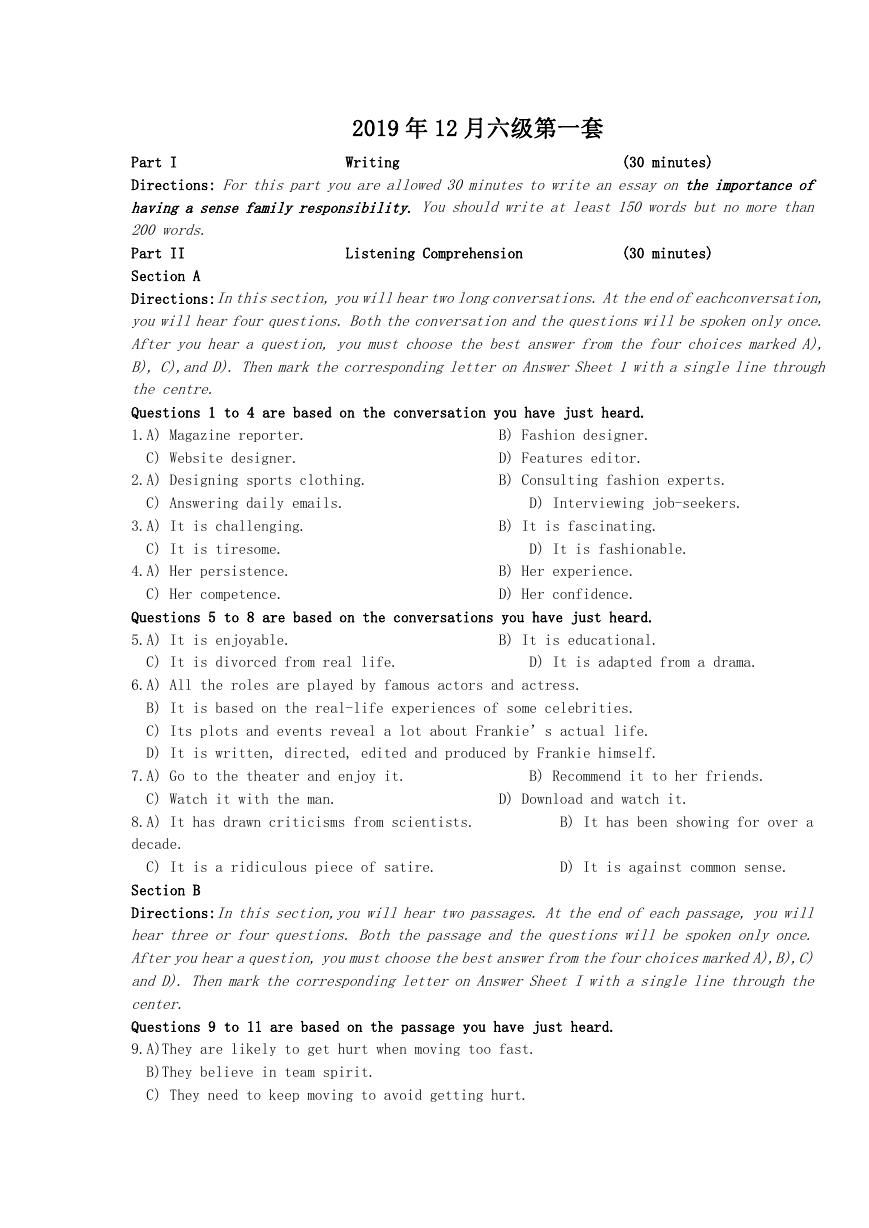
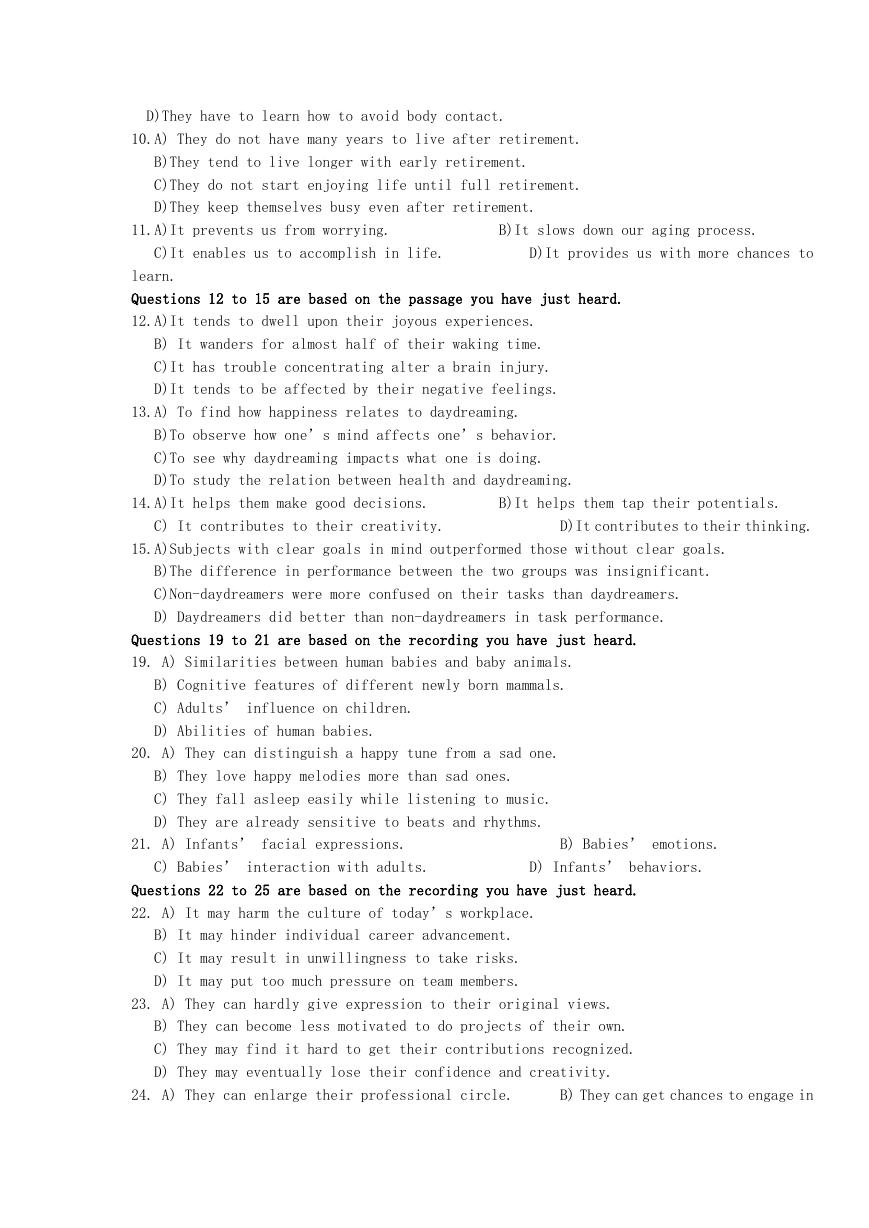
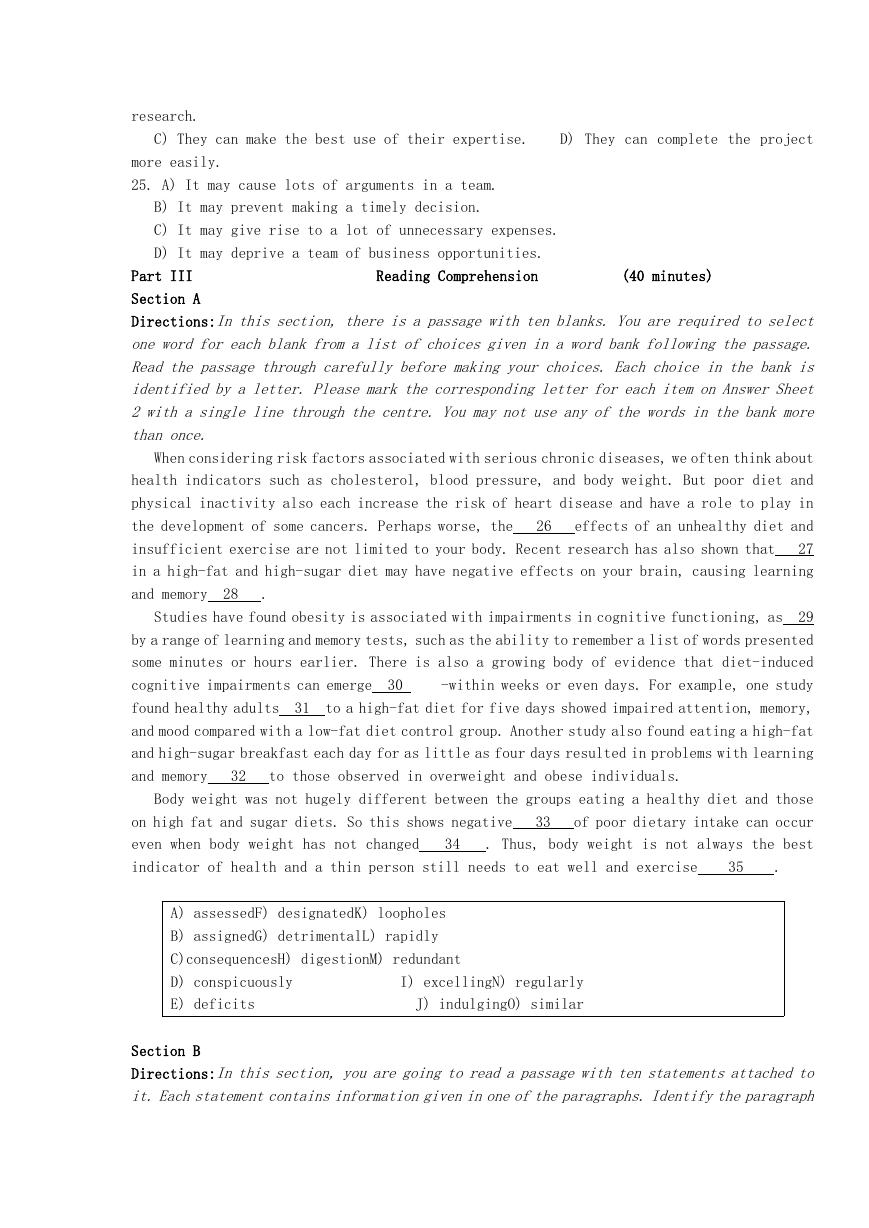
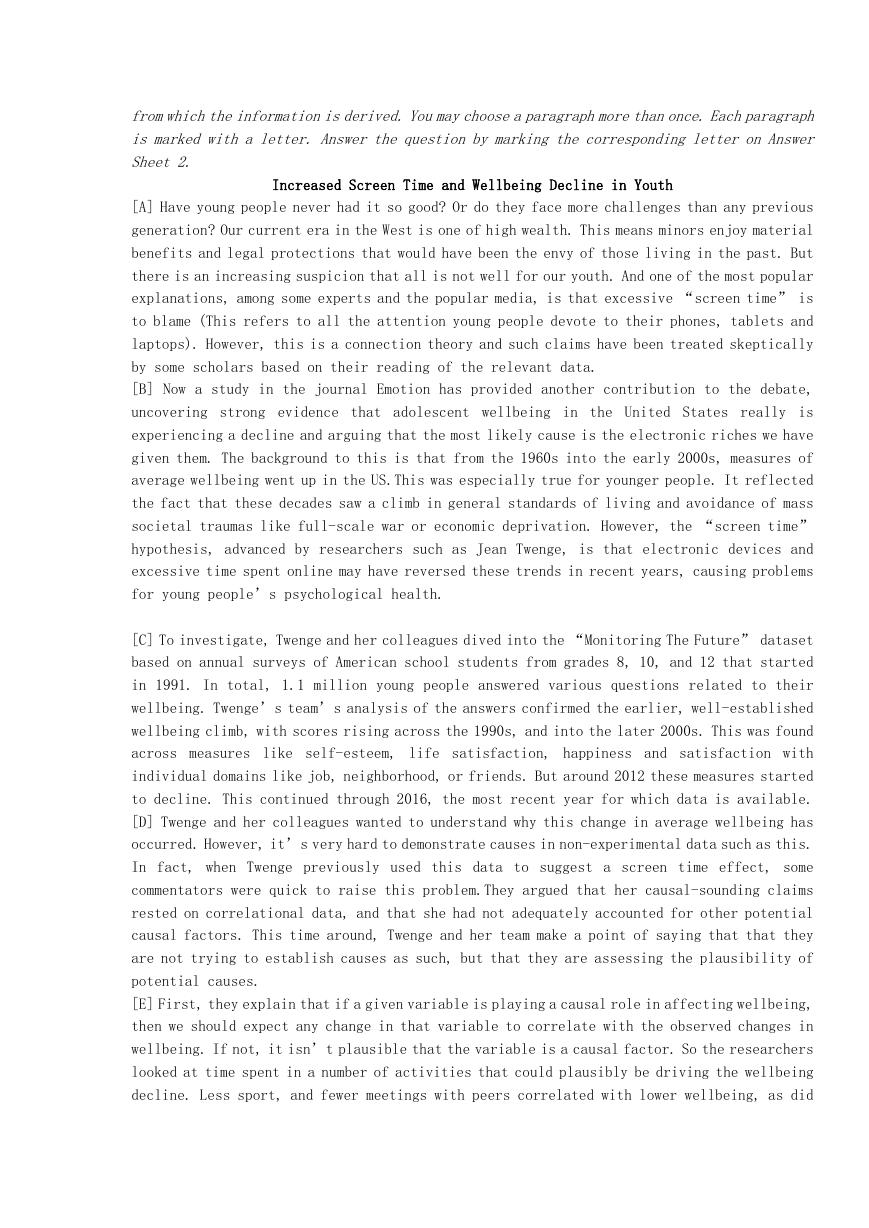
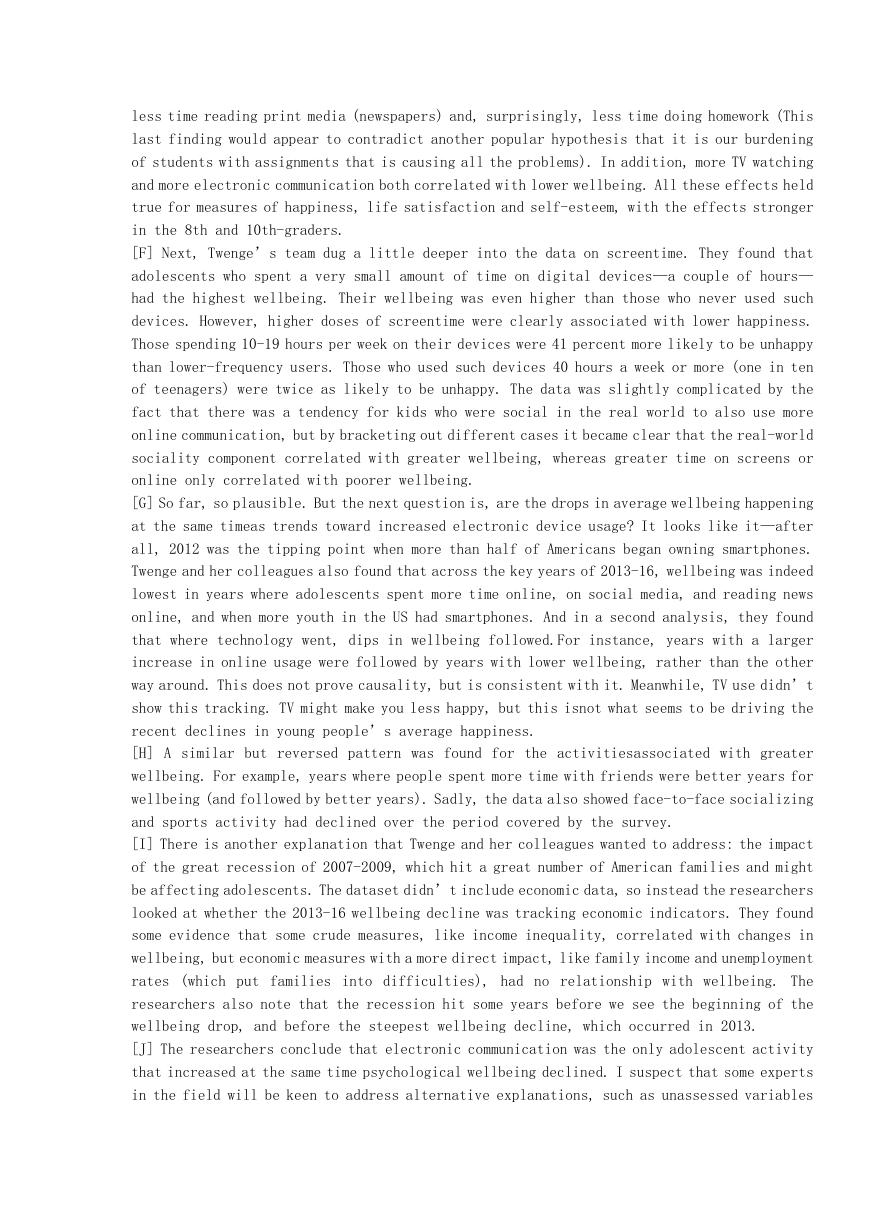
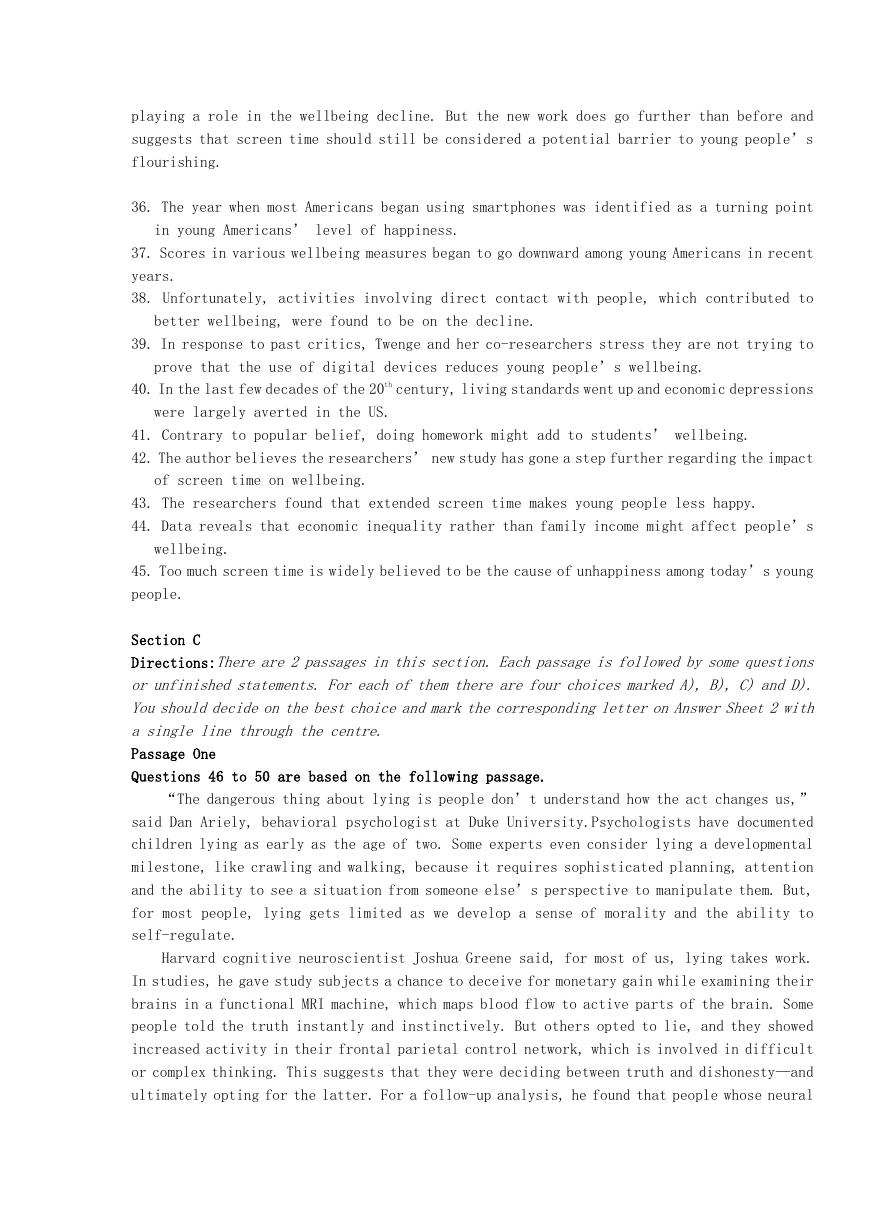
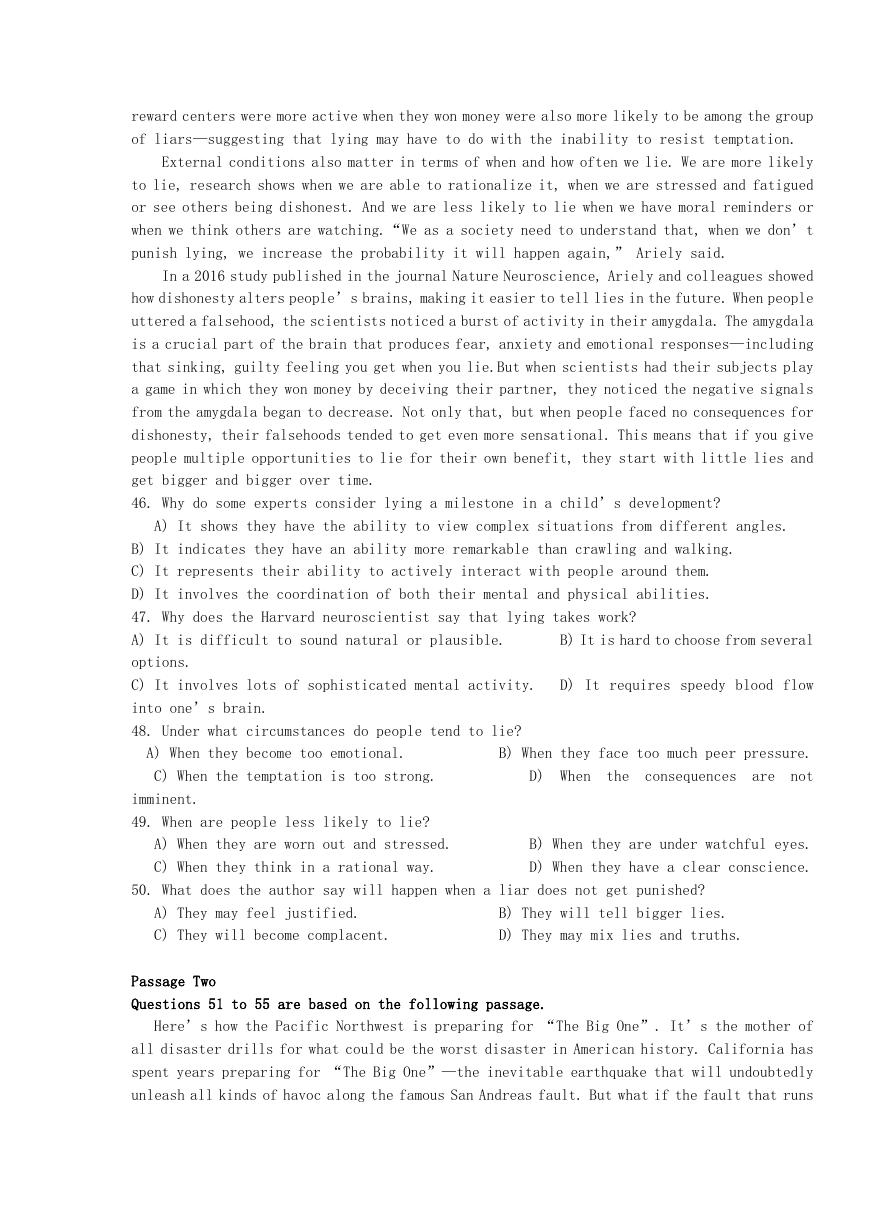
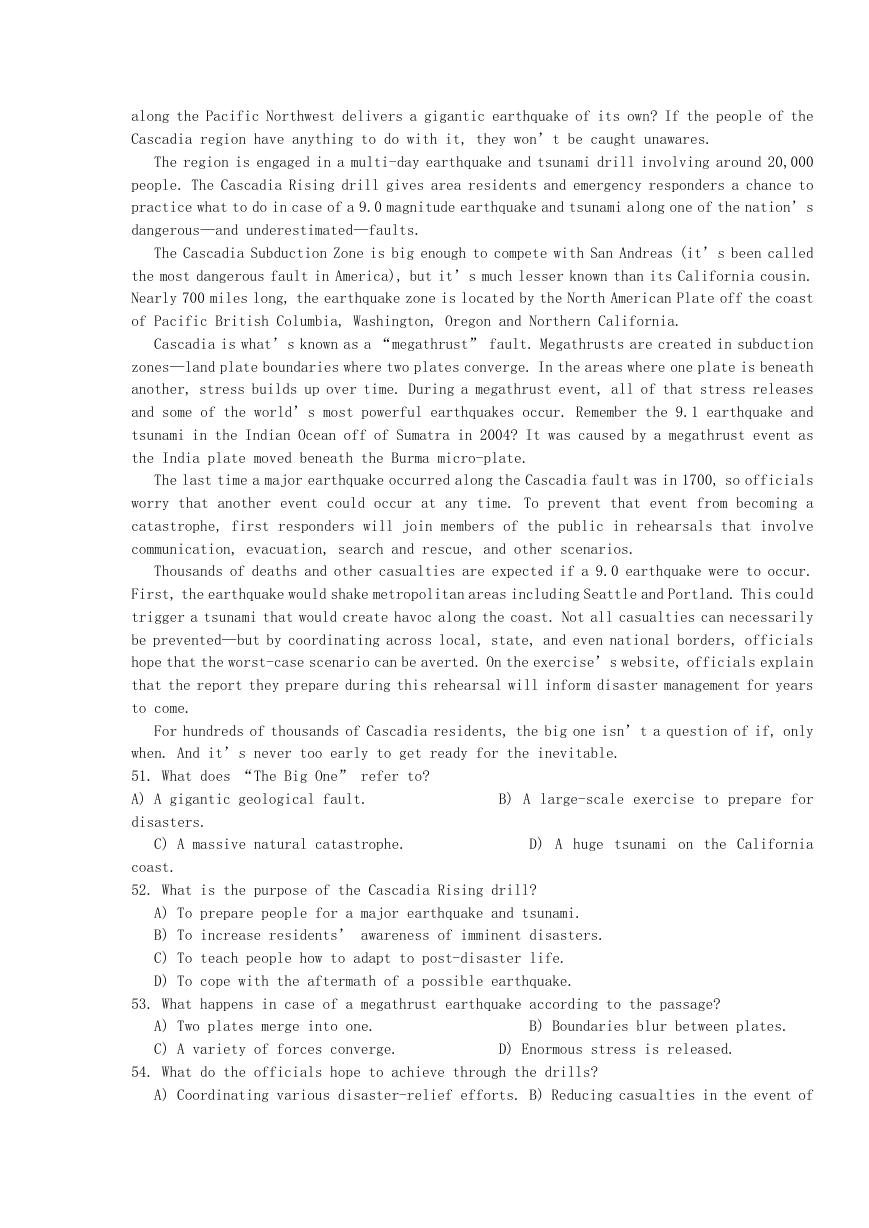








 2023年江西萍乡中考道德与法治真题及答案.doc
2023年江西萍乡中考道德与法治真题及答案.doc 2012年重庆南川中考生物真题及答案.doc
2012年重庆南川中考生物真题及答案.doc 2013年江西师范大学地理学综合及文艺理论基础考研真题.doc
2013年江西师范大学地理学综合及文艺理论基础考研真题.doc 2020年四川甘孜小升初语文真题及答案I卷.doc
2020年四川甘孜小升初语文真题及答案I卷.doc 2020年注册岩土工程师专业基础考试真题及答案.doc
2020年注册岩土工程师专业基础考试真题及答案.doc 2023-2024学年福建省厦门市九年级上学期数学月考试题及答案.doc
2023-2024学年福建省厦门市九年级上学期数学月考试题及答案.doc 2021-2022学年辽宁省沈阳市大东区九年级上学期语文期末试题及答案.doc
2021-2022学年辽宁省沈阳市大东区九年级上学期语文期末试题及答案.doc 2022-2023学年北京东城区初三第一学期物理期末试卷及答案.doc
2022-2023学年北京东城区初三第一学期物理期末试卷及答案.doc 2018上半年江西教师资格初中地理学科知识与教学能力真题及答案.doc
2018上半年江西教师资格初中地理学科知识与教学能力真题及答案.doc 2012年河北国家公务员申论考试真题及答案-省级.doc
2012年河北国家公务员申论考试真题及答案-省级.doc 2020-2021学年江苏省扬州市江都区邵樊片九年级上学期数学第一次质量检测试题及答案.doc
2020-2021学年江苏省扬州市江都区邵樊片九年级上学期数学第一次质量检测试题及答案.doc 2022下半年黑龙江教师资格证中学综合素质真题及答案.doc
2022下半年黑龙江教师资格证中学综合素质真题及答案.doc